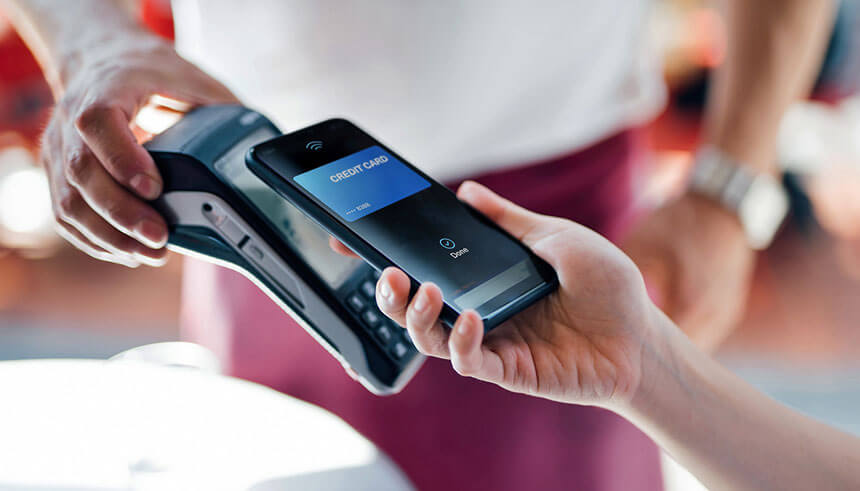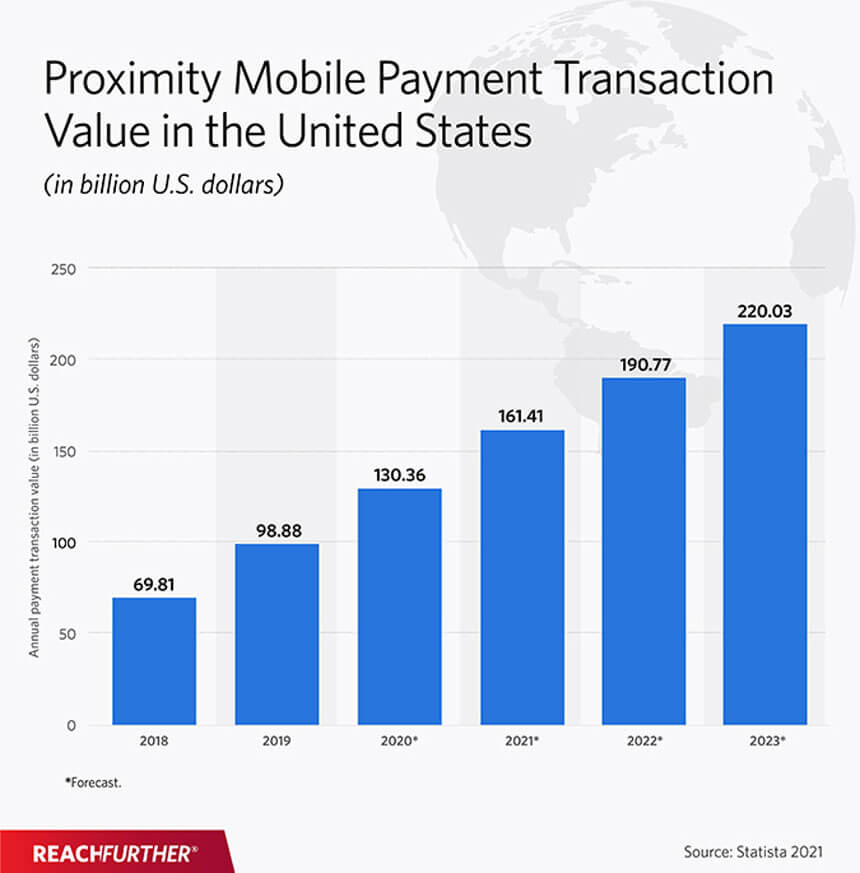Insights
Pay by Phone: The Power of Mobile Wallets for Merchant Payments
By Daisy Lin

Whether it’s Apple Pay, Google Pay, or Samsung Pay, how your business can accept NFC mobile payments and grow
Is your business leveraging the power of mobile wallets yet? The pandemic is proving to be the tipping point for contactless payments, as 87% of U.S. consumers now say they would rather shop at businesses where virtual payments are offered, according to a recent study. Shoppers are spending big money: Mobile payments made by phone, watch, or other wearable devices are growing by double digits annually, with mobile payment transaction value in the U.S. expected to top $161 billion this year.
As the global payment industry evolves, merchants can benefit by adopting new technology to stay current, according to Dustin Sullivan, vice president and national merchant sales manager at East West Bank.
“It was a shift that was in the process of happening. The pandemic definitely sped that shift up,” Sullivan says.
The benefits of mobile payments include faster checkout that is completely touchless, which results in a better experience for customers and staff, along with increased data security.
“It streamlines things. At a restaurant, for example, the wait staff can bring a machine to the customer’s table and have them pay there, and that’s one less trip running back to the bar,” Sullivan says.
How does a mobile wallet work?
A mobile wallet is a digital version of your actual wallet, powered by software that stores payment information and passwords on a mobile device. It can be a built-in feature on a smartphone, or can be downloaded through an app store. A mobile wallet can hold credit cards, tickets, coupons, or rewards card information.
When customers check out of a store, they can scan the merchant’s QR code to activate their mobile wallet or “tap to pay” by holding their mobile device over a point of service (POS) smart terminal, triggering radio frequencies that transfer the mobile wallet payment data to the terminal. This technology is called near field communication, or NFC. Mobile wallets can be used for online purchases on desktop and laptop computers, as well.
There is a variety of mobile wallets, and a smart terminal will accept almost all of them. The most popular mobile wallets include Apple Pay for iPhones, Google Pay for Androids and Samsung Pay for Samsung devices. These payment platforms are quickly expanding internationally, and it is estimated that by 2023, there will be 1.31 billion mobile wallet users worldwide.
“There are innovations happening in digital wallets based on regional preferences, range of payment services, spending patterns, and the types of businesses starting to accept these types of virtual payments,” says Disha Lal, first vice president and GTS product manager at East West Bank.
Companies such as Starbucks integrate mobile wallets into their app, linking it with a customer loyalty program that uses rewards to incentivize return business and purchases. Other apps—such as Venmo—also can generate a QR code unique to each user that the merchant can scan to draw payment from the customer’s mobile wallet.
Are mobile wallets safe?
Mobile wallets provide significantly more security than credit cards, for consumers as well as merchants. To use Apple Pay, for example, users must have a passcode set on their phone, and they can also add biometric authentication by activating Face or Touch ID. When the payment data is transferred between devices, the information is encrypted at the point of sale and re-encrypted when it is sent to the credit card company.
“When the customer scans the phone over the terminal, it’s tokenizing the card so you can't even see the card numbers that you're getting an approval for, so there’s a lot less potential for theft or card skimming at your business,” according to Sullivan, who says that protecting your business with the latest compliance technology is like getting insurance against fraud attempts on digital channels, which increased 35% during the pandemic.
“I’ve seen a compliance breach shut down an entire business. They had so many fraud claims, and the credit card companies charged such heavy fees as penalty for not securing data properly, that in the end they couldn't stay afloat anymore,” Sullivan says.

How to accept mobile wallets at your business
To activate mobile payments, start with a professional assessment of your current merchant services set up, and how you’re planning to grow in the future. If you already have an NFC-enabled smart terminal, you may be able to just add software to help you accept mobile wallets. For more capabilities, it is worth investing in a smart terminal or upgrading equipment to fit your goals and your line of business. A payments expert can help you select a credit card processor that accepts mobile wallets, form a holistic plan that’s flexible and grows with your business needs, and provide training to your team.
“We focus on truly understanding the customer—not just where they are today, but their long-term plan. We also ask questions like how do you handle your payroll, how do you handle your inventory, what do you do with timekeeping and bookkeeping? Many business functions can be bundled in a single smart terminal, and you may be able to consolidate your vendors and save money in the long run,” Sullivan says.
Once your needs are assessed, then the merchant services manager can arrange to have the software of your choice preloaded onto a smart terminal before it gets shipped out.
“So when you receive it, all you have to do is plug and play, and it works right out of the box,” Sullivan says.
Contact East West Bank Merchant Services Team
Subscribe to the Reach Further Newsletter
Get inspiring stories in your inbox every month.

